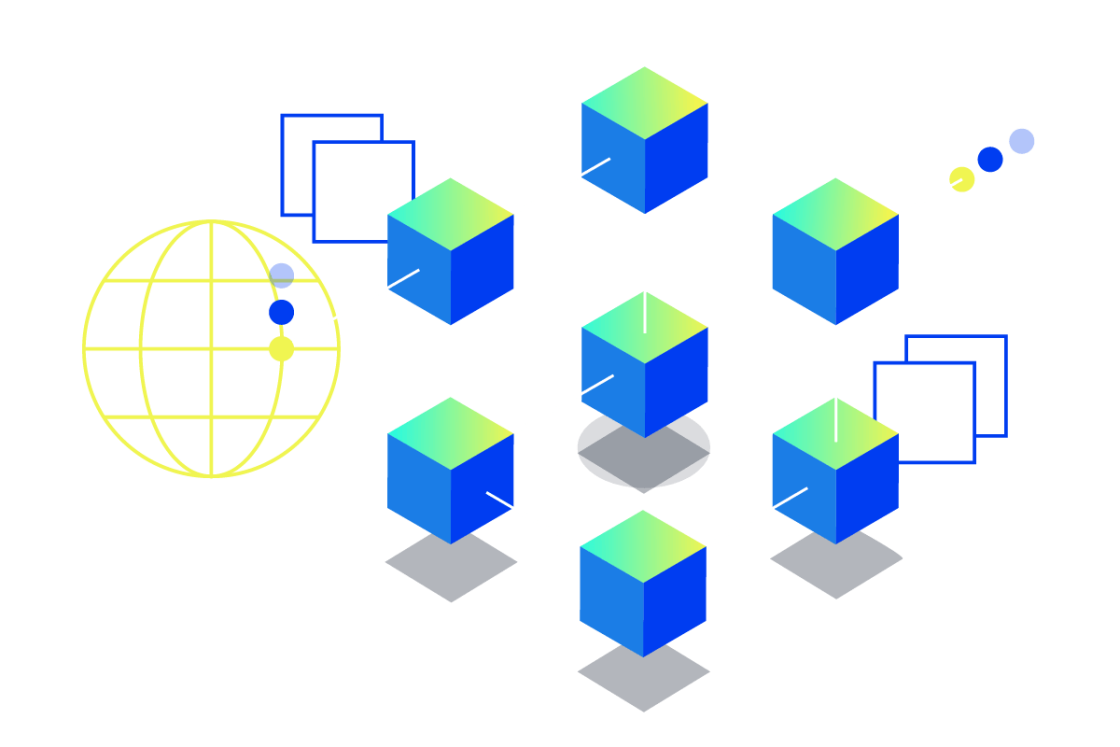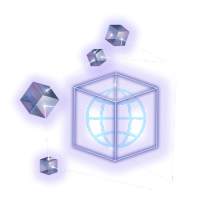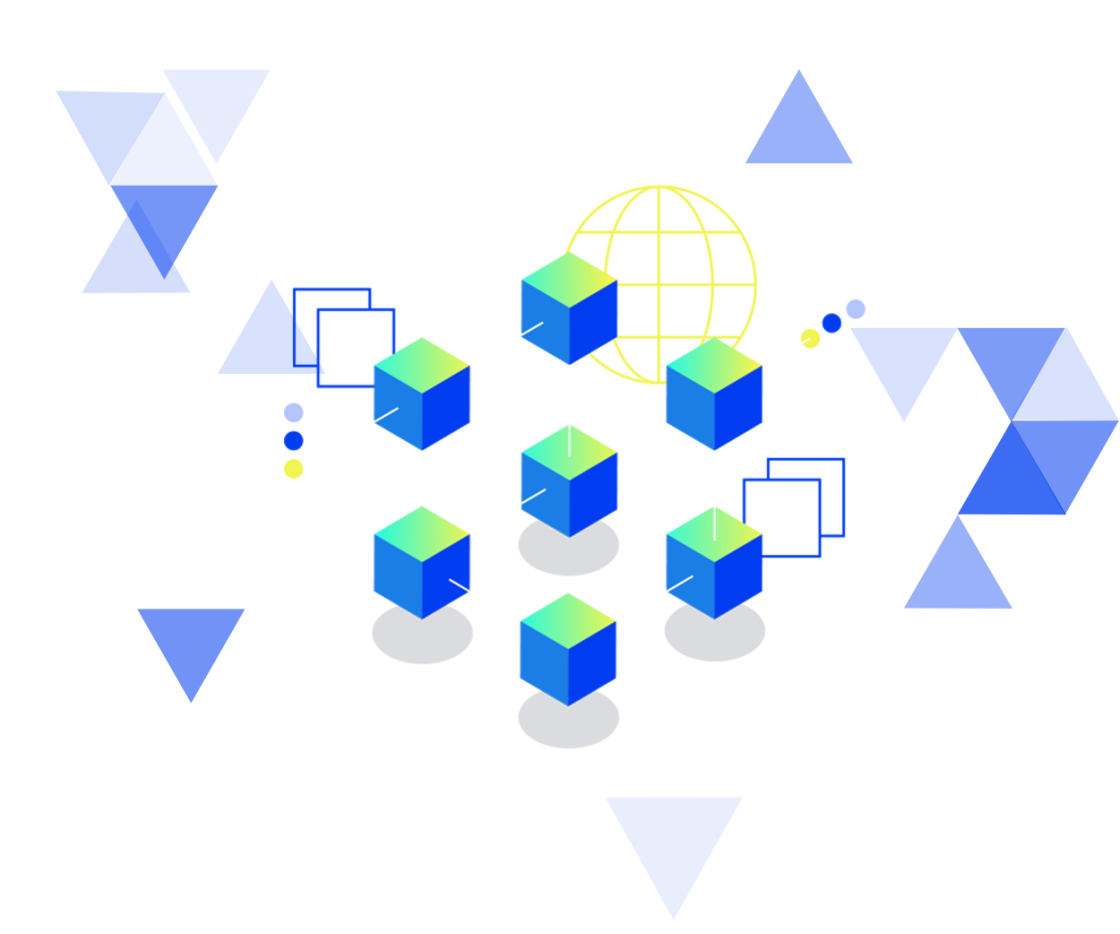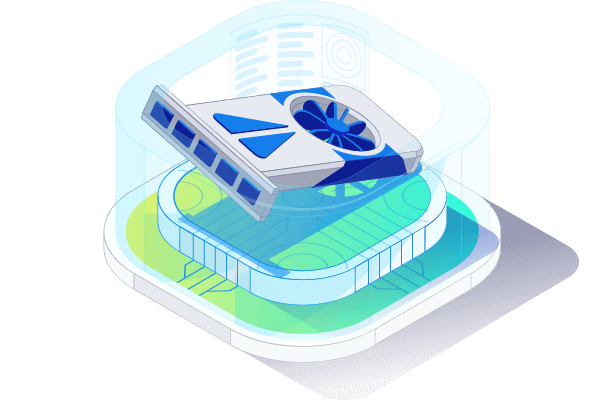What Is a Decentralized Blockchain?
What Is a Decentralized Blockchain?
Blockchain technology and blockchains have revolutionized the way we think about data, trust, and transactions in the digital age. At its core, a decentralized blockchain is a distributed ledger system that operates without a central authority, relying instead on a network of participants to validate and record information.

This new structure eliminates single points of failure, empowering users with greater control over their data and assets. Unlike traditional centralized systems, where a single entity, such as a bank or government, oversees operations, decentralized blockchains distribute power across a global network of nodes, ensuring transparency, security, and resilience.
The Web3 concept of decentralization in blockchain systems from the need to create trustless environments where participants can interact without intermediaries. This innovation originated with Bitcoin in 2009 and has since expanded into various applications, ranging from finance to supply chains.
In this article, we'll explore what decentralized finance on blockchains like Bitcoin and Ethereum truly means, its new benefits and challenges, real-world examples, historical evolution, industry impacts, future trends, and how infrastructure providers like OVHcloud are supporting these ecosystems. By understanding decentralized blockchains, businesses and individuals can harness their potential for more secure, efficient, and equitable digital interactions.
What Does Decentralization Mean in Blockchain?

A decentralized blockchain network is a peer-to-peer system where data is stored and managed across multiple nodes, rather than in a single centralized database. Each node in the network holds a copy of the entire ledger, and transactions are verified through consensus mechanisms like proof-of-work or proof-of-stake. This setup ensures that no single entity controls the network, making it resistant to censorship and manipulation.
In essence, decentralization means distributing authority and decision-making power among participants. For instance, in a decentralized network, users can propose new changes, validate transactions, and even govern the protocol's rules through community-driven processes. This contrasts with centralized systems, where a governing body dictates terms. According to industry estimates, over 80% of blockchain projects today emphasize decentralization to foster trust and inclusivity, allowing global participation without geographic or institutional barriers.
Decentralized blockchains operate on principles of immutability and transparency. Once data is added to the chain, it cannot be altered without network consensus, creating a tamper-proof record. This is particularly valuable in scenarios requiring verifiable histories, such as financial transactions or legal agreements. As blockchain adoption grows, with projections indicating a blockchain’s total market size exceeding $1 trillion by 2030, understanding these networks becomes crucial for enterprises aiming to integrate them into their operations, even if it's not something like Bitcoin.
Key Characteristics of a Decentralized System
Decentralized systems are characterized by several core characteristics that distinguish them from traditional architectures. First and foremost is distribution: control is spread across numerous nodes, each contributing to the network's maintenance and upkeep. This redundancy enhances fault tolerance; if one node fails, others continue operations seamlessly.
Another key trait of blockchains is their consensus-driven approach to digital decision-making. Participants agree on the validity of transactions through algorithms that prevent fraud, such as Byzantine Fault Tolerance, which ensures agreement even if some nodes act maliciously. Transparency is also paramount—every transaction is publicly verifiable on the ledger, reducing the need for trust in intermediaries.
Immutability ensures that once recorded, digital data remains unchanged, providing a reliable audit trail. Additionally, decentralization promotes inclusivity, allowing anyone with internet access to participate, democratizing access to technology. Studies show that decentralized networks like blockchains can process transactions up to 10 times more efficiently in terms of cost compared to centralized counterparts, thanks to the elimination of middleman fees.
Security for new and existing blockchains, such as Bitcoin, is bolstered by cryptographic techniques, where private keys grant users sole control over their assets. Finally, scalability, though challenging, is addressed through innovations like sharding, which divides the network into smaller, manageable parts. These characteristics make decentralized systems ideal for applications requiring high reliability and user empowerment.
How Decentralization Improves Blockchain Security and Trust
Decentralization fundamentally enhances security by eliminating new single points of attack. In centralized systems, a breach in one server can compromise the entire network. Still, in decentralized blockchains, attackers must overpower a majority of Bitcoin nodes—often thousands worldwide—to alter data. This distributed nature makes hacks exponentially more difficult and costly.
Trust in blockchains is established through cryptographic proofs and consensus mechanisms.Users don't need to trust a central authority; instead, they rely on digital mathematical verification. For example, zero-knowledge proofs allow validation without revealing sensitive information, preserving privacy while ensuring integrity. Industry reports indicate that decentralized networks have reduced fraud incidents by up to 70% in sectors like finance, where trust is paramount.
Moreover, decentralization fosters resilience against censorship. Governments or corporations cannot easily shut down the network, as seen in cases where centralized cryptocurrency platforms have been blocked during political unrest. This trustless model encourages adoption, with over 100 million active blockchain wallets worldwide, reflecting growing confidence in these systems.
By distributing power, decentralization also mitigates insider threats, as no single entity holds absolute control over the system. This leads to more equitable ecosystems, where users can audit and participate in governance, further solidifying trust.

Benefits and Limitations of Decentralized Blockchain Systems
The advantages of blockchains and decentralized architectures are profound, starting with unparalleled transparency. Every transaction is recorded on a public ledger, accessible to all, which minimizes hidden fees or manipulations common in centralized finance. This crypto openness has enabled cryptocurrency and other platforms to handle trillions in financial value without traditional oversight.
Trust is inherently built in, as crypto participants verify each other's actions through consensus, reducing reliance on third parties. In business contexts, this translates to faster settlements—often in minutes versus days—and lower digital costs, with some decentralized exchanges reporting fee reductions of 90% compared to banks.
Censorship resistance is another key benefit. Decentralized systems operate globally, beyond the reach of any single digital jurisdiction, protecting users in restrictive environments. For instance, during economic crises, decentralized currencies have provided stable alternatives, preserving wealth for millions of people.
Additionally, these digital architectures promote innovation by allowing open-source development, where communities collaborate on improvements. Environmental benefits also emerge, with energy-efficient consensus models reducing consumption by half in newer protocols.

Challenges and Risks (Governance, Scalability, Energy Consumption)
Despite benefits, decentralized systems face significant challenges. Governance for cryptocurrencies is often contentious, with decision-making processes slowed by the need for broad consensus, which can lead to cryptocurrency forks or stalled upgrades. Scalability remains a hurdle; popular networks like Ethereum have experienced congestion, with transaction fees spiking during peak times.
Energy consumption is a major concern, particularly for proof-of-work systems, which can rival the electricity use of small countries. Although transitions to proof-of-stake have reduced this by 99% in some cases, environmental impact persists as a criticism.
Security risks include 51% attacks, where a majority stakeholder could manipulate the cryptocurrency chain, although they are rare due to the high costs associated with them. Regulatory uncertainty also looms, with governments grappling to classify decentralized assets, which could potentially stifle innovation.
Interoperability between chains is limited, fragmenting ecosystems and complicating cross-network interactions. Finally, user adoption is hindered by complexity, as managing private keys requires technical expertise, which can lead to losses due to errors.
Centralized vs Decentralized Blockchain: Key Differences
Centralized blockchains, controlled by a single entity, offer speed and simplicity but at the cost of technological vulnerability. Decentralized ones distribute control, enhancing security but introducing complexity. Key differences include authority: centralized systems have a governing body, while decentralized systems rely on community consensus.
Performance varies; centralized chains process thousands of transactions per second, versus decentralized chains often have lower throughput due to consensus overhead. However, decentralized systems excel in resilience, with no single point of failure.
Cost structures for digital options differ as well—decentralized eliminates intermediary fees but may incur higher gas costs during periods of congestion. Transparency is higher in decentralized models, as ledgers are public, whereas centralized cryptocurrencies might obscure operations, such as those in a crypto block.
Technology and financial use cases reflect this: centralized for enterprise efficiency and decentralized for trustless applications, such as DeFi. Ultimately, hybrids are emerging, offering a blend of benefits for balanced solutions.
Real-World Examples of Decentralized Governance
DAOs represent the pinnacle of decentralized digital governance, operating as organizations run by code and community votes rather than executives. Members hold tokens that grant voting rights on proposals, from funding projects to protocol changes.
For example, a DAO might manage a treasury worth billions, with decisions executed via a smart contract automatically upon vote approval. This eliminates human bias, ensuring merit-based outcomes. One notable case involved a DAO raising $150 million for investments, demonstrating how decentralized structures can rival traditional venture capital.
Challenges include low voter turnout, but innovations like quadratic voting help amplify the voices of minorities. DAOs have empowered global collaboration, with over 5,000 active ones managing diverse initiatives from art collectives to crypto and tech development.
Blockchain Voting Mechanisms and On-Chain Governance
On-chain governance integrates voting directly into the technology blockchain, allowing token holders to propose and vote on upgrades. Mechanisms like liquid democracy allow users to delegate votes, thereby increasing participation in the blockchain server.
A real-world application use is in protocols where upgrades are voted on, ensuring evolution without central control. This has led to faster adoption and user adaptation, with some networks implementing changes in weeks rather than years, compared to centralized systems.
Case studies demonstrate that voting prevents exploits; communities have swiftly patched vulnerabilities through consensus. However, risks like plutocracy—where wealthy holders dominate—persist, though weighting systems mitigate this.
DeFi Governance: Protocols and Community Decision-Making
DeFi platforms exemplify decentralized governance, where users vote on parameters such as interest rates or new features. Protocols distribute governance tokens, incentivizing participation and fostering a sense of ownership among stakeholders.
In one instance, a DeFi project adjusted its lending model via community vote, boosting liquidity by 200%. This bottom-up approach fosters innovation, with the total financial value locked in DeFi surpassing $100 billion.
Community decision-making, block by block, ensures alignment with user needs; however, technology coordination challenges can delay block responses to financial market shifts
Historical Evolution of Blockchain Decentralization
Bitcoin and later Ethereum introduced digital decentralization in 2009 as a response to financial centralization, creating a peer-to-peer electronic cash system. It's proof-of-work consensus distributed mining power, preventing control by any entity.
Ethereum built on this in 2015, adding smart contracts for programmable decentralization. This shift enabled the development of complex applications, expanding from currency to entire ecosystems.
The rise led to a surge in adoption, with Bitcoin's market cap surpassing $1 trillion, inspiring thousands of decentralized projects.
Smart contracts automate agreements, executing terms when conditions are met, enabling programmable governance. This enables DAOs to execute rules autonomously, thereby reducing the need for human intervention.
The shift has transformed use in industries, with automated insurance payouts or escrow services. Ethereum's upgrade to 2.0 enhanced this, improving efficiency.
Milestones include Bitcoin's launch, Ethereum's ICO in 2014, the DAO hack in 2016, prompting security focus, and the DeFi boom in 2020. Recent ones, such as layer-2 solutions, have further scaled block decentralization.
The Impact of Decentralization Across Industries
Decentralization has the potential to impact a broad block of digital industries. These include, for example:
- Financial Services: Decentralization has disrupted financial markets through DeFi, offering lending, borrowing, and trading without banks. Use cases include financial yield farming, where users earn returns that exceed traditional savings by a factor of 10 or more.
- Supply Chain Transparency: In supply chains, decentralized ledgers track goods immutably, reducing fraud. A food industry example traced products from farm to table, cutting recall times by 80%. Trustless collaboration enables secure partnerships without intermediaries, streamlining global technology trade and commerce.
- Data Privacy: Decentralized systems empower users with data use and control via self-sovereign identities. This enhances financial privacy, with encrypted storage preventing breaches.
Decentralized Finance in Emerging Economies
Emerging and developing nations stand to gain significant benefits from DeFi, such as crypto, as the technology addresses three chronic pain points simultaneously—limited banking reach, expensive remittances, and unstable local currencies. 1.7 billion adults worldwide remain “unbanked,” yet two-thirds own a smartphone. Digital DeFi applications convert those phones into miniature, border-agnostic bank branches, letting users store financial value, earn yield, and access credit in minutes instead of weeks.
- Micro-savings and yield: Traditional micro-savings programs often pay near-zero interest because local banks cannot profitably service small accounts. DeFi vaults accepting deposits as low as a few cents automate the back-end, eliminating branch overhead and passing higher returns—sometimes 5–10 percent annually—to depositors. Because smart contracts execute payouts on-chain, savers witness interest accumulating in real-time, which increases trust and financial literacy.
- Low-cost remittances: Migrant workers sent US$860 billion home in 2024, losing an average of 6 percent to intermediaries. DeFi remittance rails built on stablecoins settle in under a minute for pennies in network fees. Families receive funds directly in a wallet, bypassing cash-out lines and predatory currency exchanges. Some wallets automatically convert a portion of incoming funds into inflation-resistant assets, such as tokenized Treasury bills, thereby shielding households from domestic currency depreciation.
- Grass-roots credit: Informal street vendors and smallholder farmers rarely possess the collateral or credit histories required by commercial banks. DeFi lending protocols reverse the equation: collateral lives on-chain (e.g., tokenized harvest receipts or community reputation tokens), and underwriting logic is public, rules-based, and bias-free. Because liquidity comes from a global use of a pool of lenders chasing yield, interest rates trend lower than local micro-finance institutions that rely on costly field officers. Communities that previously borrowed at 30 percent annual interest can secure working capital at single-digit rates, directly boosting household income.
- Currency stability via stablecoins: Countries battling double-digit inflation watch as citizens gravitate to dollar-pegged stablecoins for day-to-day pricing, creating an organic buffer against macro-economic shocks. Retailers accept QR-code payments, settling instantly in a unit of account everyone trusts. In effect, DeFi becomes a parallel monetary system that coexists with, and sometimes disciplines, volatile domestic currencies.
- Cooperative insurance: Weather-indexed crop insurance delivered through smart contracts pays farmers automatically when satellite data shows rainfall below a threshold. Payouts arrive in hours, not months, preventing distress sales of livestock and seed. Because claims assessment is algorithmic, administrative costs drop sharply, making coverage affordable for the first time.
- Human-capital investing: Novel DeFi protocols let overseas supporters purchase “learning tokens” tied to a student’s future earnings, funding tuition upfront. Smart contracts route a small, predefined share of post-graduation income back to token holders, aligning incentives while sidestepping usurious private student loan markets.
While these breakthroughs are compelling in use, risks mirror those in wealthier markets—smart-contract exploits, volatile yields, and regulatory gray zones. However, the relative upside is greater: shifting a remittance corridor from 6 percent fees to 0.2 percent is life-changing in villages where every dollar counts.
Governments in Africa, South Asia, and Latin America are experimenting with “regulatory sandboxes” that grant DeFi startups temporary licenses to operate under lighter reporting requirements, striking a balance between consumer protection and innovation.
For international development agencies and impact investors, DeFi offers measurable, real-time transparency. All transactions are traceable on public ledgers, letting donors verify that micro-loans reach intended recipients and that interest rates comply with fair-lending mandates. This built-in audibility could reduce corruption, a persistent obstacle in aid distribution.
Future of Decentralized Blockchain Technology
Future dApps will integrate AI for smarter interactions, like predictive analytics in DeFi. Projections estimate that dApp users will reach 1 billion by 2030.
Innovations like zero-knowledge rollups in use will boost privacy and scalability, enabling enterprise adoption. Governance will become more inclusive, with the integration of AI-assisted voting and cross-chain interoperability, ultimately leading to the development of global decentralized economies.
OVHcloud and Decentralized Blockchain
In the rapidly evolving landscape of decentralized technologies, a robust and reliable infrastructure is paramount to success. This section explores the powerful synergy between OVHcloud's enterprise-grade cloud solutions and the demanding world of blockchain.

